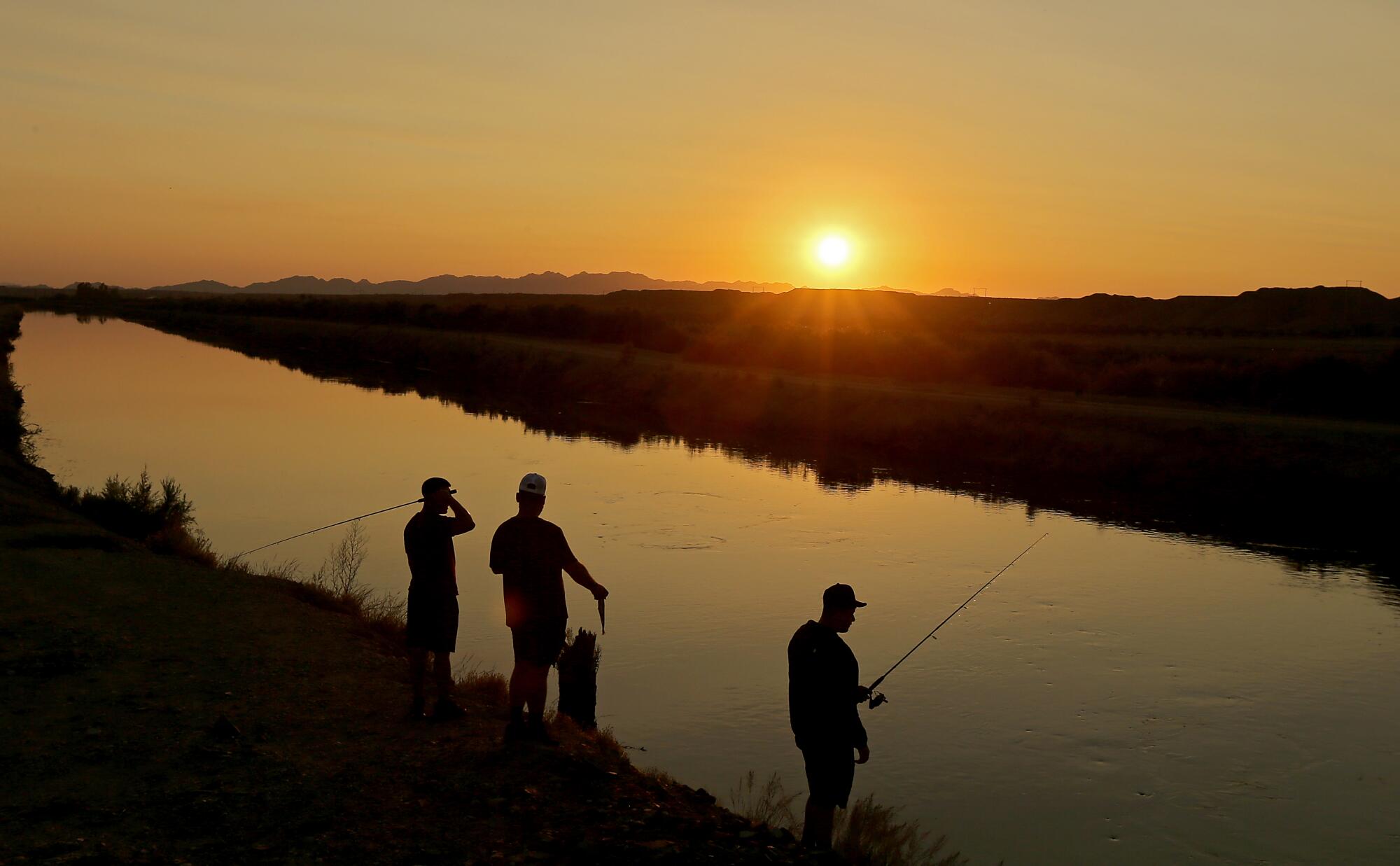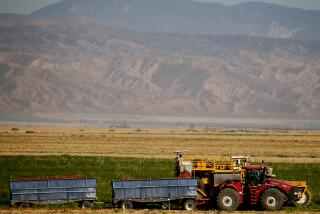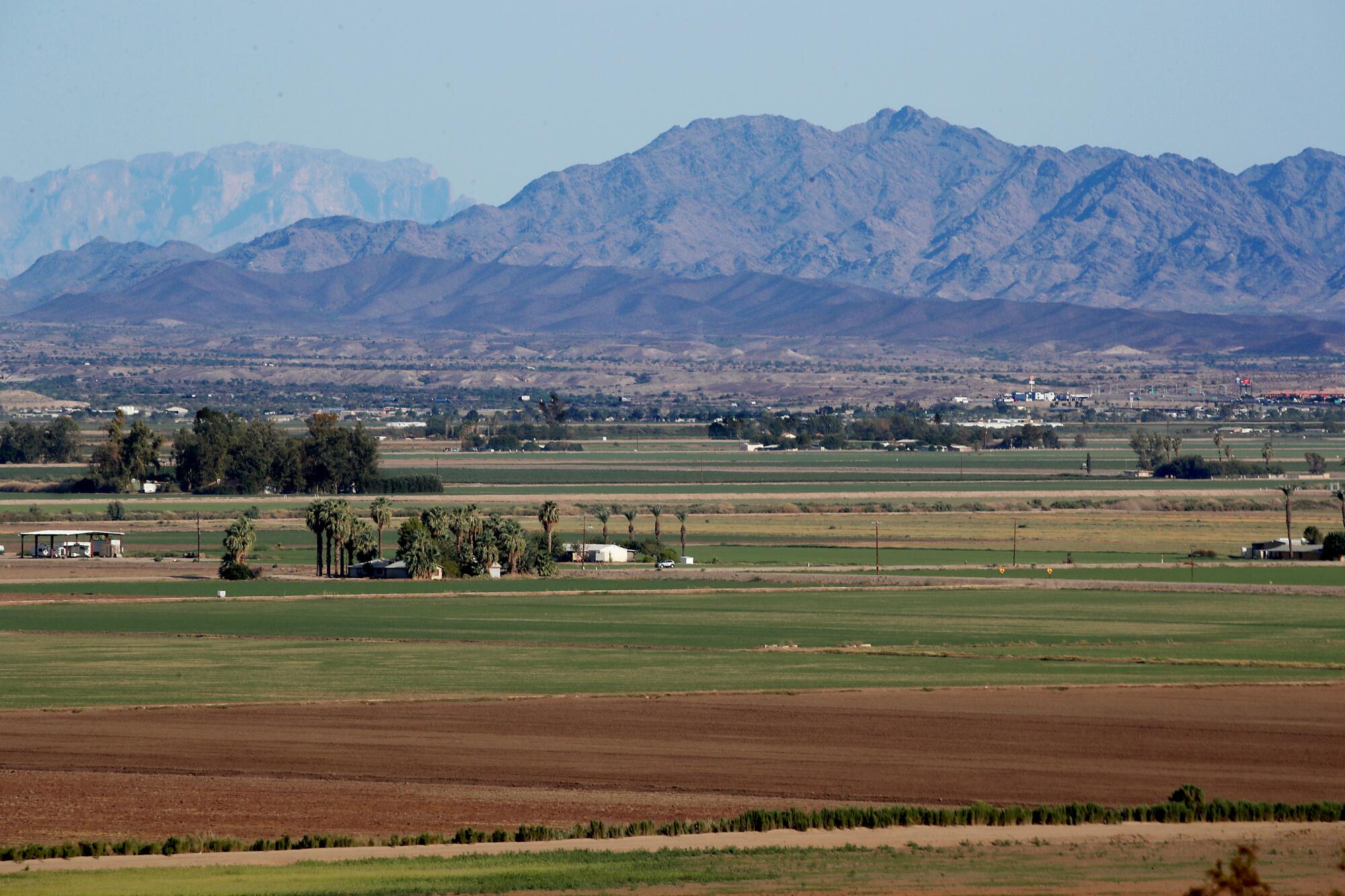
- Share via
BLYTHE, Calif. — Green fields of alfalfa and cotton rolled past as Brad Robinson drove through the desert valley where his family has farmed with water from the Colorado River for three generations. Stopping the truck, he stepped onto a dry, brown field where shriveled remnants of alfalfa crunched under his boots.
The water has been temporarily shut off on a portion of Robinson’s land. In exchange, he’s receiving $909 this year for each acre of farmland left dry and unplanted. The water is instead staying in Lake Mead, near Las Vegas, to help slow the unrelenting decline of the largest reservoir in the country.
Robinson and other growers in the Palo Verde Irrigation District are taking part in a new $38-million program funded by the federal Bureau of Reclamation, the Metropolitan Water District of Southern California and other water agencies in Arizona and Nevada. The farmers are paid to leave a portion of their lands dry and fallow, and the water saved over the next three years is expected to translate into 3 feet of additional water in Lake Mead, which has declined to its lowest levels since it was filled in the 1930s following the construction of Hoover Dam.
“Honestly, I think I could make more money farming. But for the sake of the Colorado River, I think it’s the right thing to do,” Robinson said. “The river’s going through a bad time right now.”
The arrangement is one of a growing number of programs that are springing up along the river to find water savings in agricultural areas. As reservoirs continue to decline, managers of water districts are looking to start or scale up similar land-fallowing programs in other areas, paying farmers not to farm temporarily on some fields and using the water to ease shortages.
Although the program in the Palo Verde Valley amounts to a minuscule boost for the shrinking Colorado River, the approach has been praised by water officials and local growers as one way of adapting to a river that yields less after years of severe drought intensified by the warming climate. Robinson and other growers in Palo Verde say they hope their participation may encourage other water agencies to start similar initiatives and enlist more farmers to fallow land to help address the increasingly dire condition of the river.
Even as they take part in the program, some farmers remain suspicious of the powerful Metropolitan Water District and its intentions in their community. The MWD has bought thousands of acres of farmland around the town of Blythe over the years and has recently agreed to buy more land, eliciting fears among farmers that the water agency in Los Angeles could one day seek to take more water and dry up a larger portion of their valley.
“They’ve got a large portion of this valley. Why do they need more?” asked farmer Charles Van Dyke.
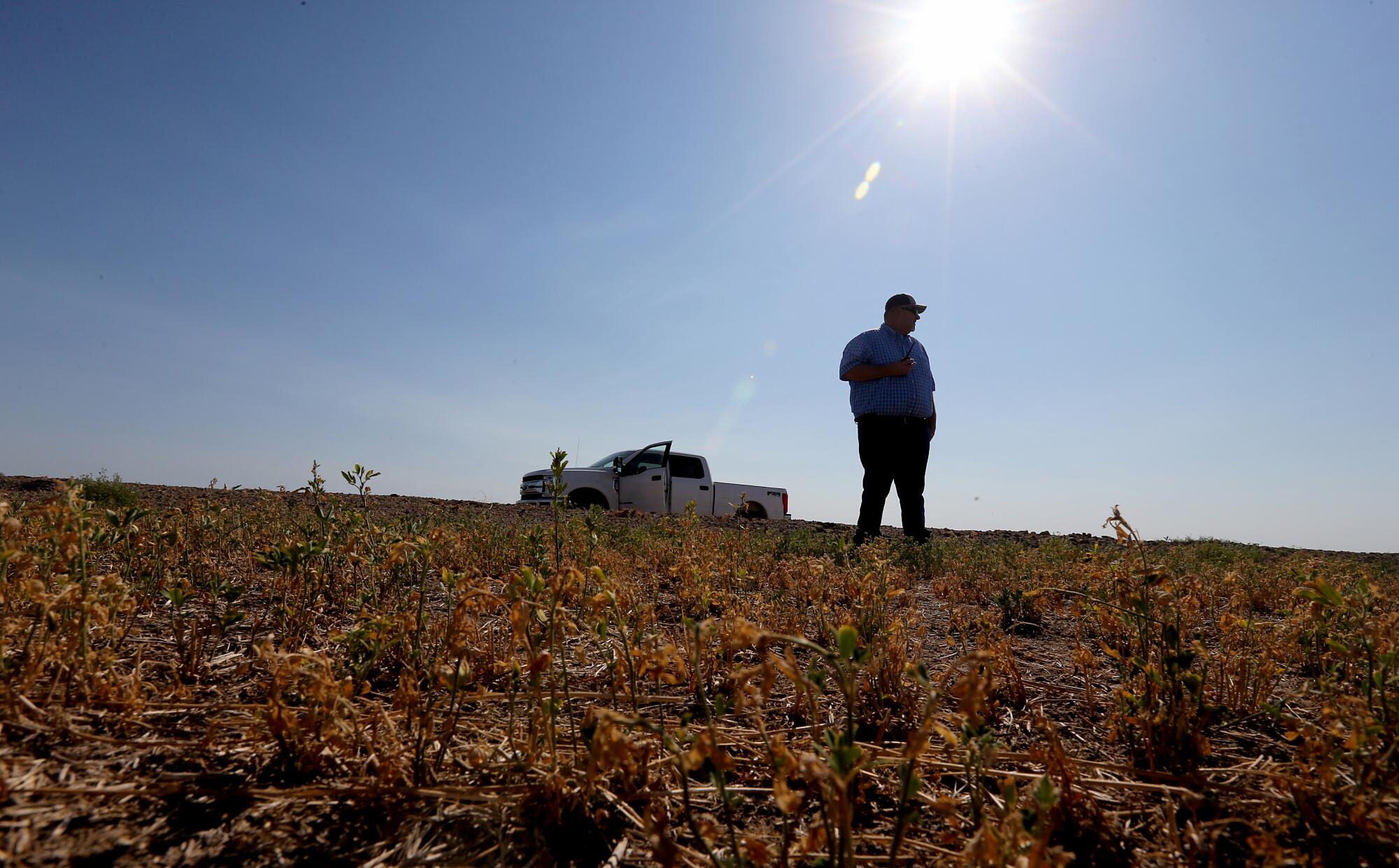
The Colorado River has long been chronically over-allocated, with so much water diverted to supply farms and cities that the river has for decades rarely reached the sea in Mexico. Most of that diverted water — approximately 70% — irrigates farmland, and much of that water flows to thirsty crops such as hay and cotton, which are exported in large quantities.
Since 2000, the river’s flow has shrunk during one of the driest 22-year periods in centuries. Scientists have described the last two decades as a megadrought, and one that’s being worsened by the heating of the planet with the burning of fossil fuels. Researchers have warned that long-term “aridification” of the Colorado River Basin means the region must adapt to a river that provides less water.
The water level in Lake Mead has declined 27 feet since January 2020. The reservoir now stands at just 34% of full capacity, placing it at a shortage level that will trigger mandatory water cutbacks next year for Arizona, Nevada and Mexico.
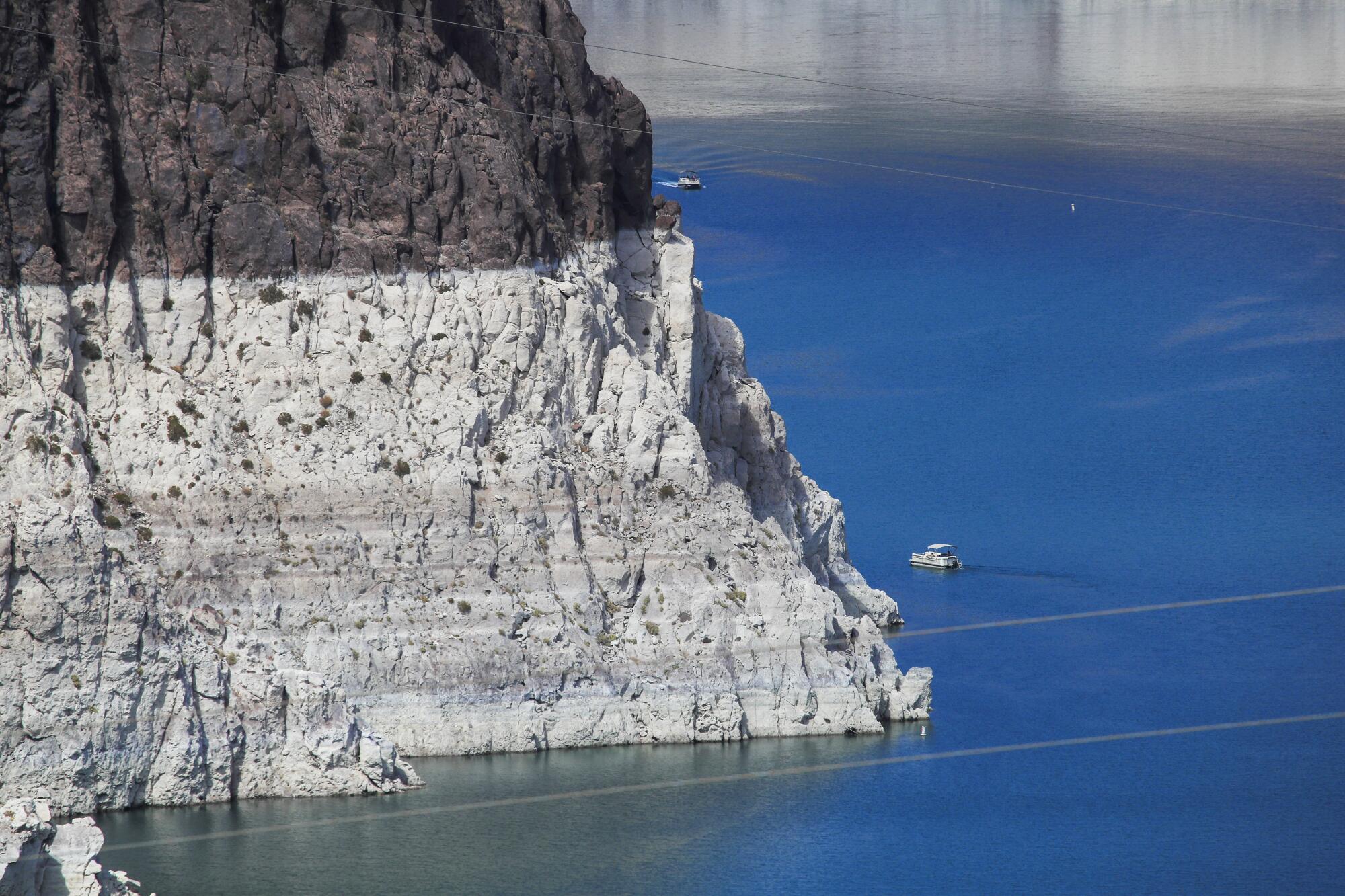
The lake’s water level is projected to continue falling. The latest estimates from the federal government show the water in Lake Mead could drop an additional 30 feet by August 2023, a level that would require water cuts in California.
Since 2005, Robinson and other farmers in the Palo Verde Valley have left portions of their lands dry and unplanted under a 35-year deal with the Metropolitan Water District, which has paid them more than $180 million for water that was sent flowing through the Colorado River Aqueduct to cities in Southern California. Under the new deal, much of the water will instead be left in Lake Mead to try to reduce risks of the reservoir falling to critically low levels.
For managers of the MWD, the program offers flexibility, enabling them to pay for more land-fallowing in years when they need more water.
Each year, the MWD calls for a certain percentage of the valley’s farmlands, up to a maximum of 28%, to be left fallow. Starting this year, the water from a portion of those lands is staying in Lake Mead.
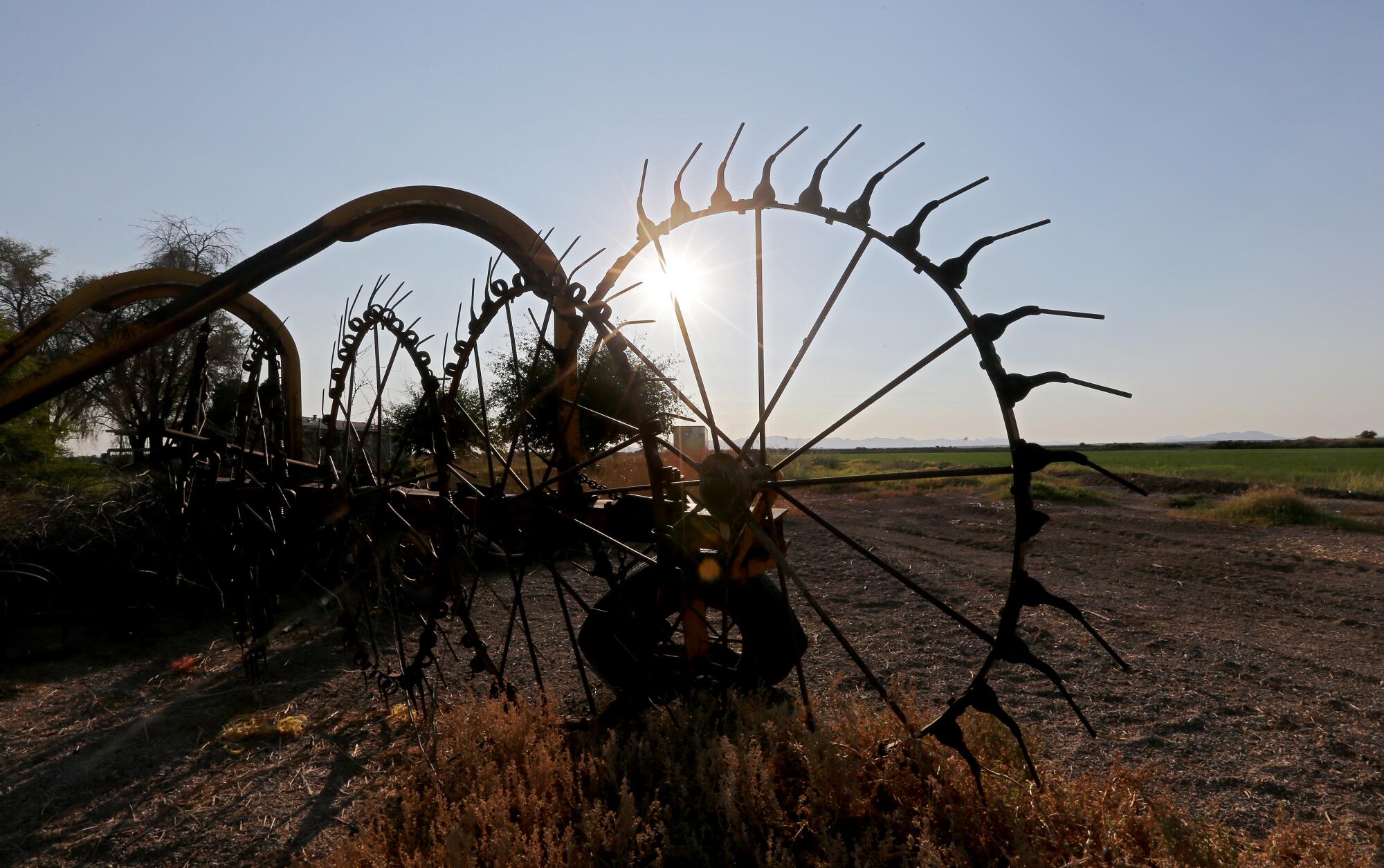
Similar programs have taken shape in several areas along the Colorado River.
Last year, the MWD began paying farmers in the smaller Bard Water District not to plant water-intensive crops such as alfalfa in the spring and summer, while they continue growing higher-value winter crops such as lettuce, broccoli and cauliflower.
And the MWD’s board is considering paying for seasonal fallowing under another proposed agreement with the Quechan Indian Tribe, whose reservation borders Arizona, California and Mexico, and includes farms that produce hay and vegetable crops.
Other initiatives are underway across the river in Arizona. Under agreements aimed at slowing the decline of Lake Mead, leaders of the Colorado River Indian Tribes have been leaving some farmlands dry, and landowners in the Mohave Valley Irrigation and Drainage District have also been forgoing some water in exchange for payments.
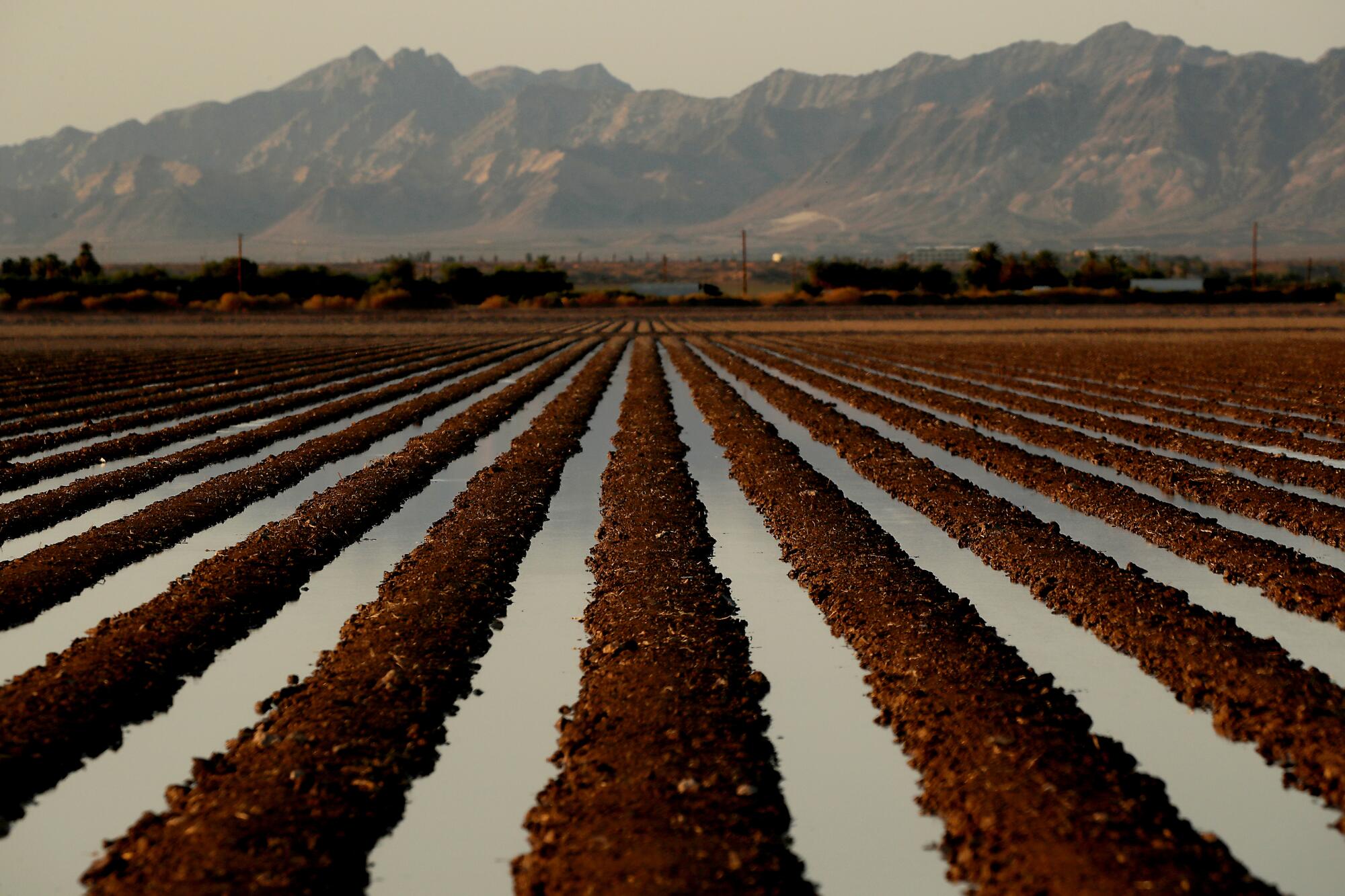
To support more fallowing of land in the Palo Verde Valley, the federal government is contributing half the funding — $19 million — while the rest is coming from the Central Arizona Project, the Southern Nevada Water Authority and the MWD.
“This is just the beginning,” MWD General Manager Adel Hagekhalil said when the deal was announced in August. “We’re working to develop other innovative ideas to keep as much water as possible in Lake Mead.”
The program demonstrates how urban and agricultural water districts can work together to deal with shortages, said Bill Hasencamp, MWD’s manager of Colorado River resources.
“A lot of other states and other regions are looking to those programs as examples of what can be done elsewhere,” Hasencamp said. “We want to set a good example of how farmland can be productive in the era of shrinking water supplies.”
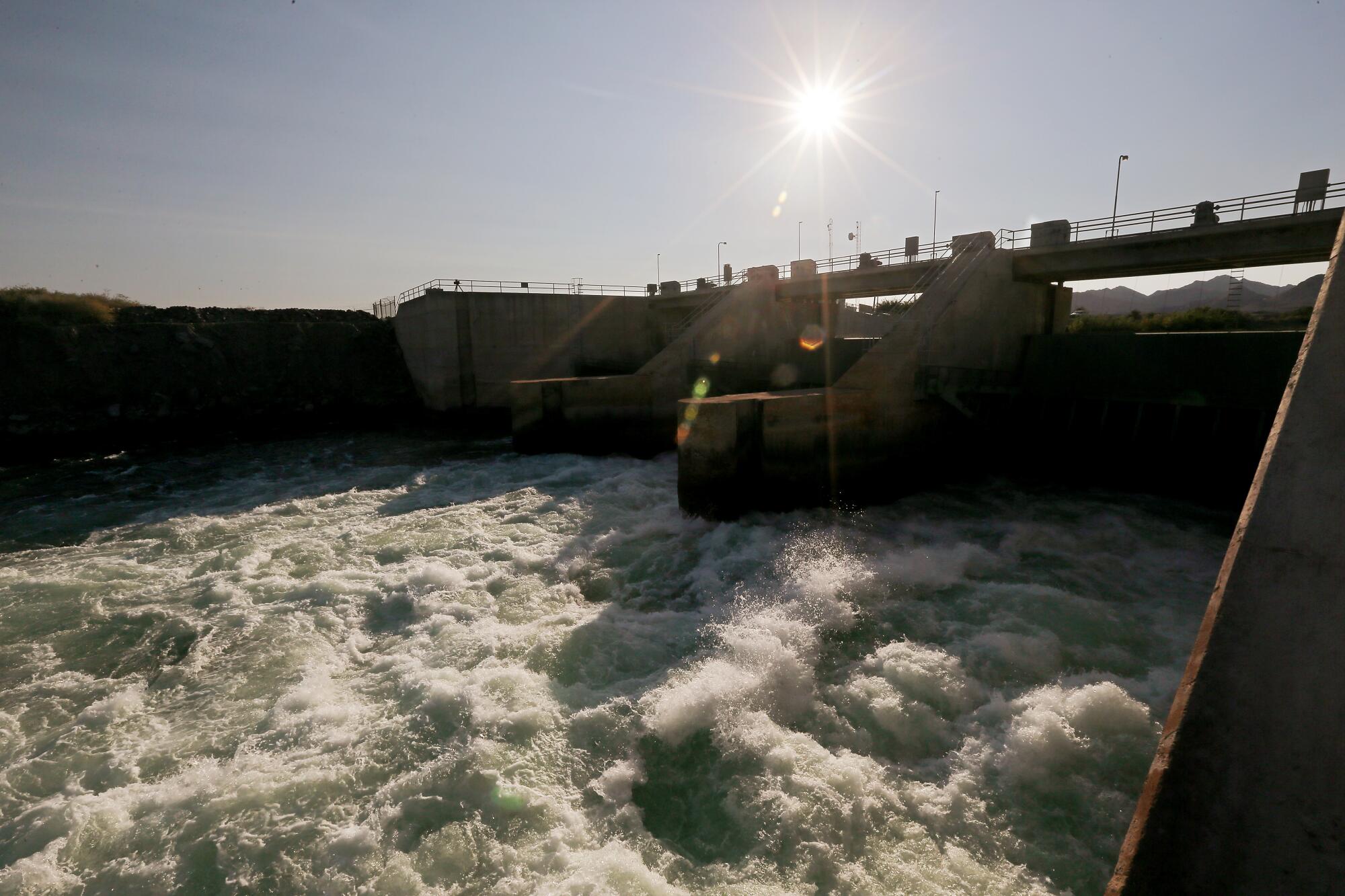
Reducing reliance on the Colorado River, he said, will require bigger water-saving efforts in cities and farming communities alike. The MWD supplies water to cities and water districts across Southern California that serve about 19 million people. The agency’s figures show that between 2011 and 2020, its water use declined about 7% — in part thanks to the lasting effects of conservation campaigns during the 2012-2016 drought.
Because the latest estimates show Lake Mead is likely to continue declining, Hasencamp said, “we’re going to need to do more.”
Robinson, who is a board member of the Palo Verde Irrigation District, runs a family business that his grandfather founded in 1960. He now farms on about 3,200 acres around Blythe, including land he owns and leases. His fields produce cotton that is exported, alfalfa that is trucked to dairies in California, Bermuda grass that is baled to feed horses, and honeydews and other melons that are sold in supermarkets.
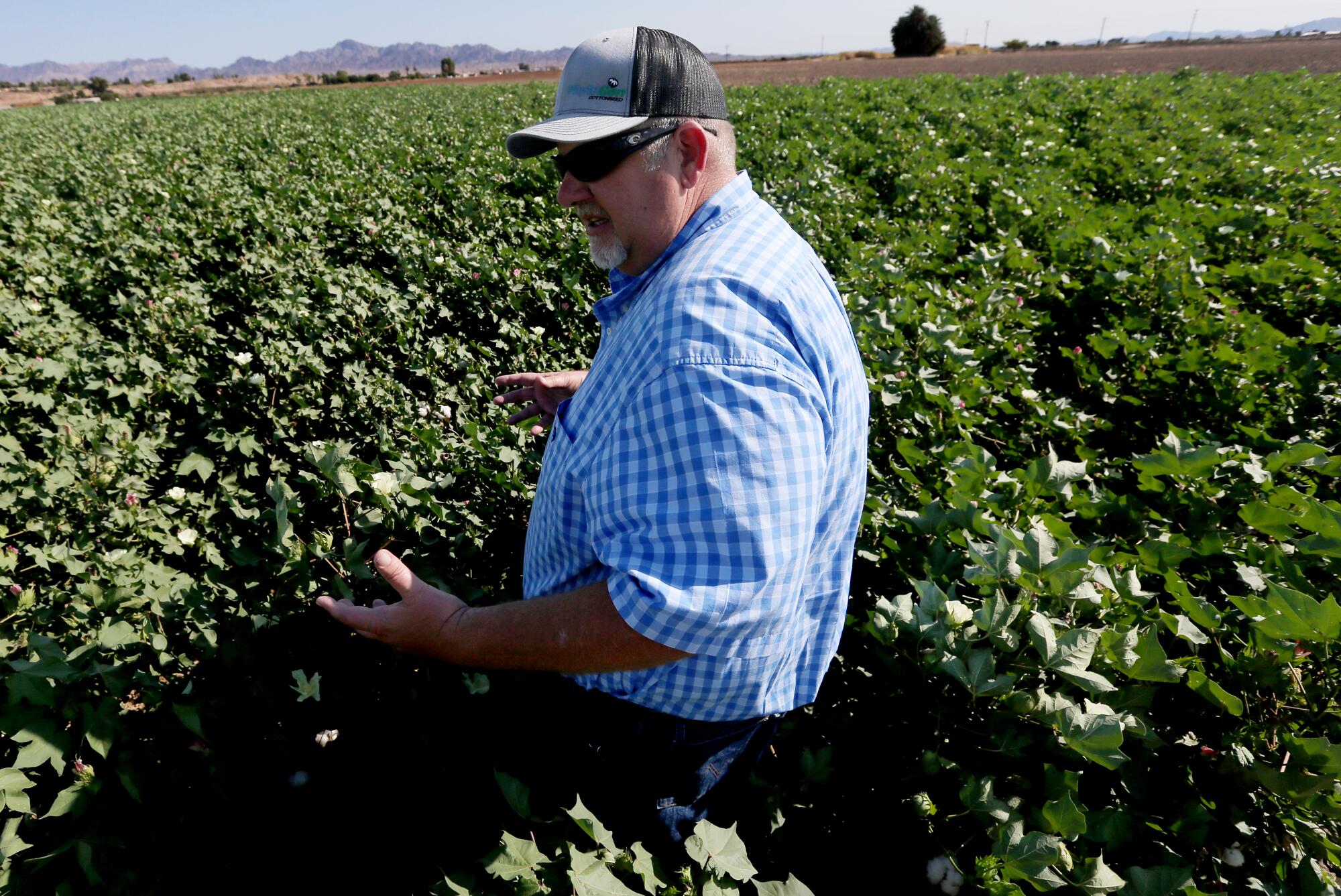
“In a perfect world, a farmer wants to farm,” Robinson said. “But the reality of the situation is that we have a certain amount of population and people, and don’t have unlimited water. So ... the two sides are going to have to work together.”
The fields that are left dry are rotated every one to five years. And for the farmers, the cash payments provide a stable chunk of income that isn’t subject to price swings.
“We’re not getting rich off this. But it helps enough on the bad years,” when crop prices are low, Robinson said. “I’ve never laid anybody off because of the fallow program, and I never intend to do so.”
The program is far from a cure-all, and will need to be combined with other steps, said Chuck Cullom, manager of Colorado River programs at the Central Arizona Project. For example, water agencies in Arizona and Nevada have offered to invest in a proposed water recycling project in Southern California. And Cullom’s agency has been investing in testing water-saving irrigation technologies on Arizona farms.
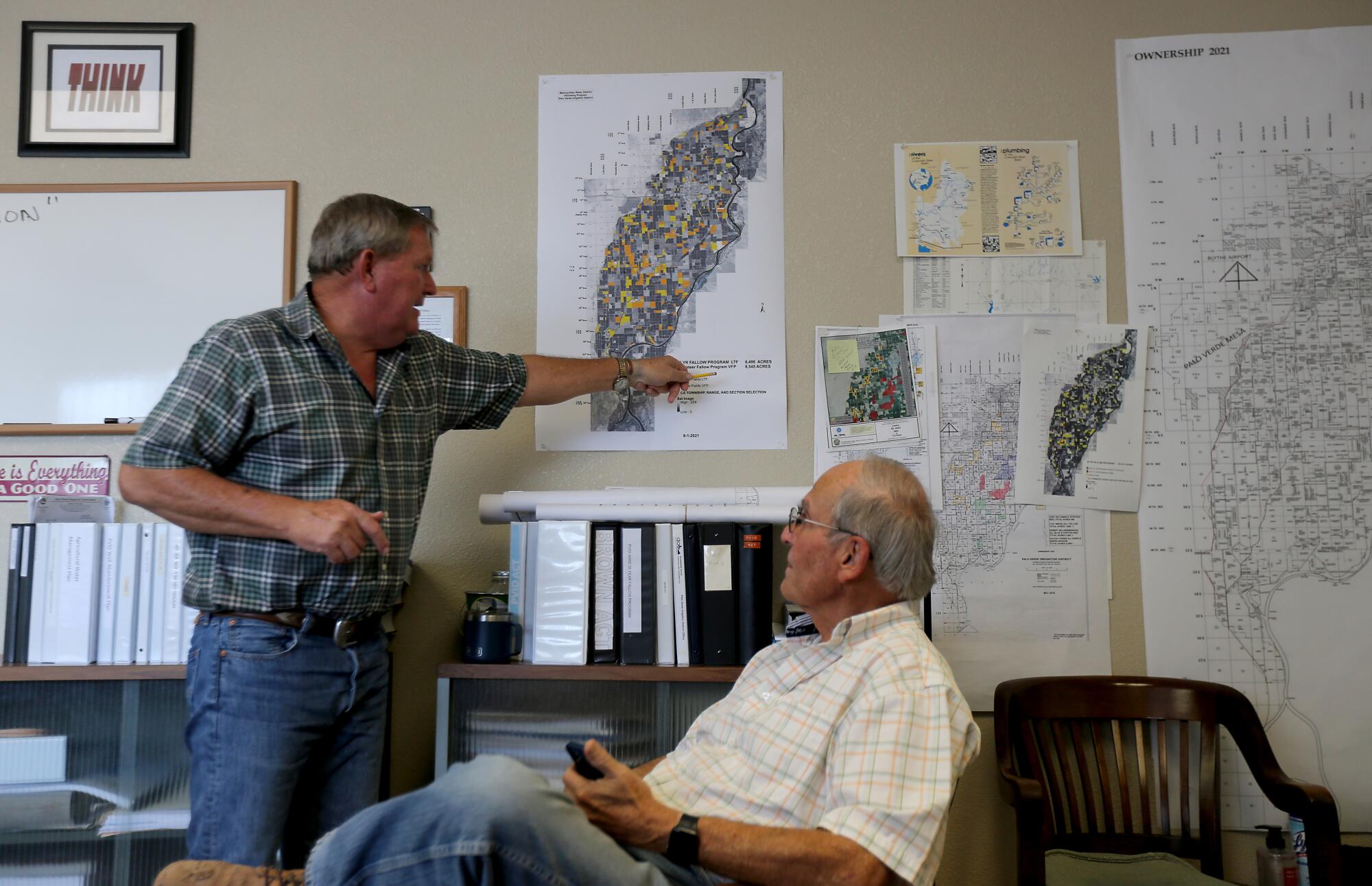
“We all share the river. We all share risk,” Cullom said. “As the system becomes more vulnerable, we need all of the sectors to work together.”
The sorts of deals that temporarily leave farmland dry help by adding flexibility to the water system, but they also raise questions as the West grapples with the effects of climate change, including hotter, more intense droughts, said Newsha Ajami, director of urban water policy at Stanford University.
“If you’re experiencing drought after drought, and the droughts are getting hotter and drier, how long can you fallow land?” Ajami said. “I think it’s a Band-Aid. It’s a temporary solution to a more long-term problem we are having.”
Some Arizona farmers are already facing cutbacks in water deliveries from the river because they hold the lowest-priority water rights.
The farmers in Blythe, in contrast, hold some of the oldest water rights on the river, dating to 1877, when investor Thomas Blythe filed a claim to use water from the river. Based on that history, the growers of the Palo Verde Valley have a first-priority position among California water districts and would be among the last in line for cuts.
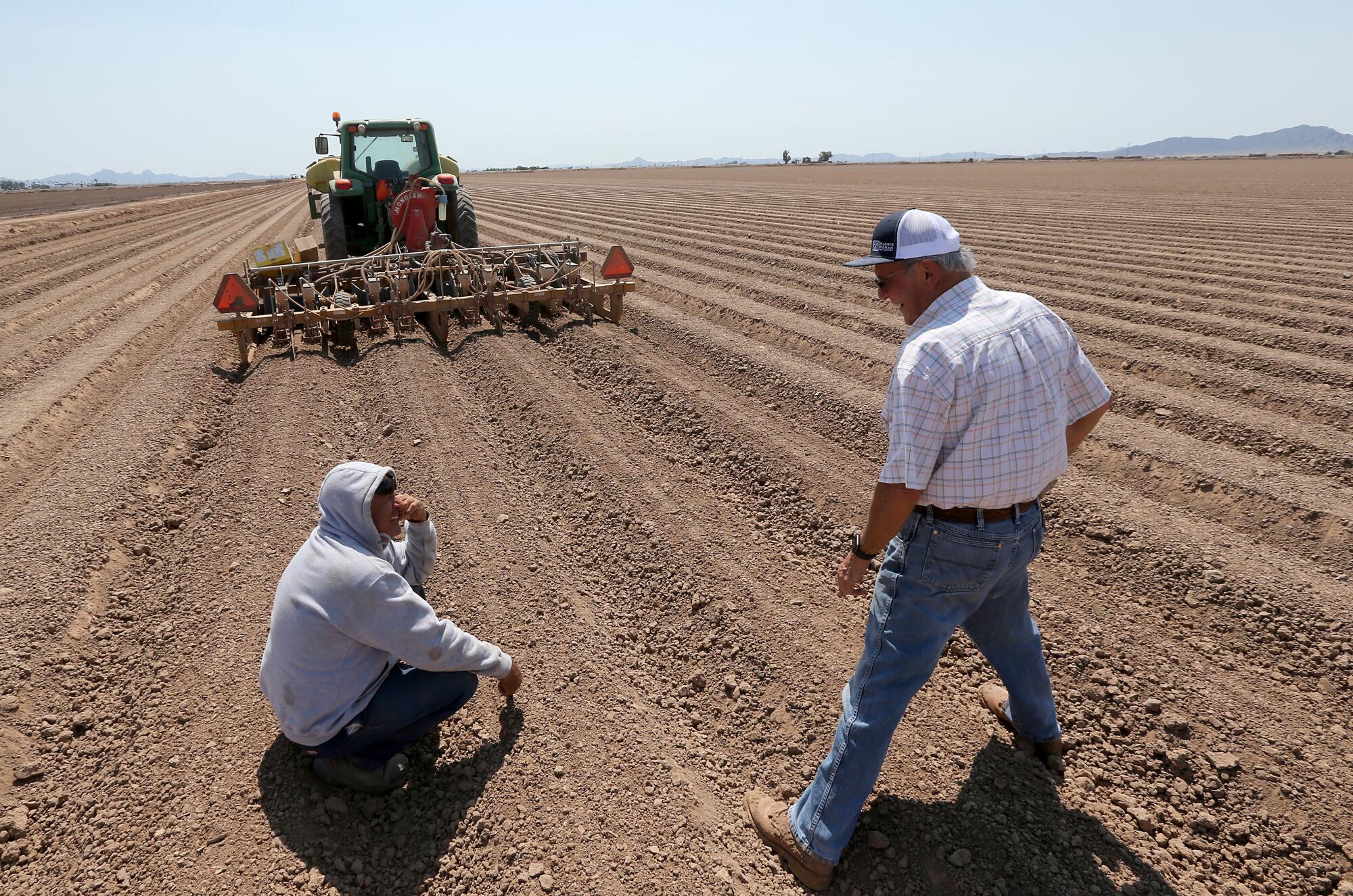
“We should be the last ones to worry about water,” said Bart Fisher, a farmer who is vice president of the irrigation district board. “But if there’s no water in the river, it really doesn’t matter.”
Fisher, who runs a farming business that his grandfather founded in 1917, said even with such solid water rights, he and other growers have reason to be concerned about the river’s worsening crisis.
“It looks grim, actually. I was born in Blythe and I’ve been here all my life, and we’ve never been so threatened,” Fisher said, looking across a dry field where bits of garlic, remnants of the last harvest, were scattered in the soil.
He also grows broccoli, melons, wheat and hay, all of which rely on Colorado River water flowing through the canals.
“We could conceivably come to a place on the Colorado River where there is not water for anybody’s needs,” Fisher said. “We’re going to diminish reservoir levels to levels that we haven’t seen before, and the question then is, how do we respond?”
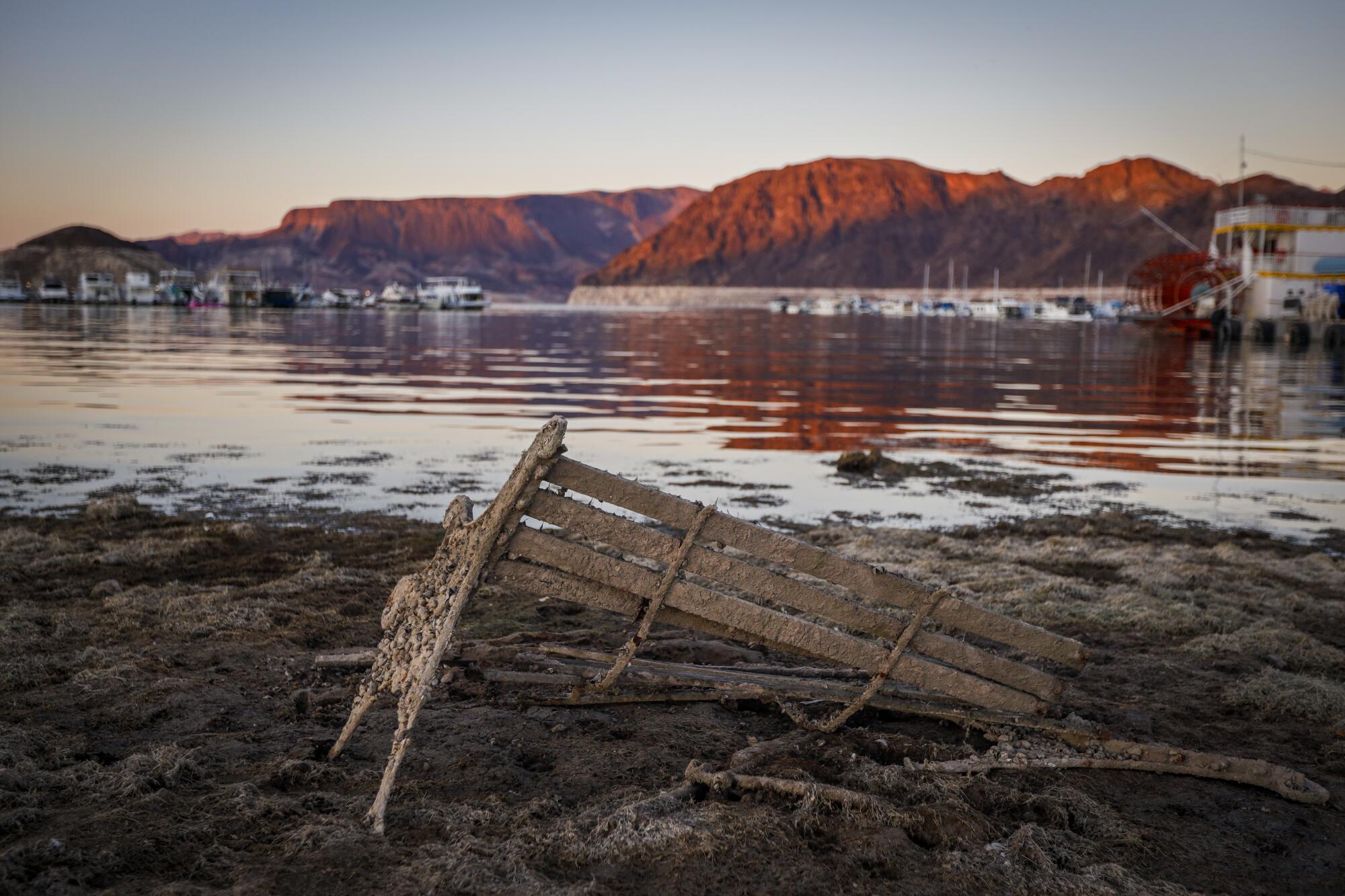
He said he hopes to see more deals emerge. If four or five other agricultural water districts pitch in, he said, their contributions could quickly add up to 10 feet or 15 feet of additional water in Lake Mead, which would make a big difference.
But even as Fisher and other farmers continue to participate in the MWD program and receive payments, they’ve also voiced concerns.
Under the deal, the MWD provided $6 million to establish a locally run community improvement fund in Blythe that has provided grants and business loans in an effort to boost the local economy. Fisher said in retrospect, that one-time payment hasn’t been enough.
Fisher drove down the main avenue, Hobsonway, where he passed shuttered businesses, including a motel, gas station, restaurant and several stores, all with boarded-up windows.
“I think we would do it a little differently today,” Fisher said. “We would ask for more community support” from the MWD.
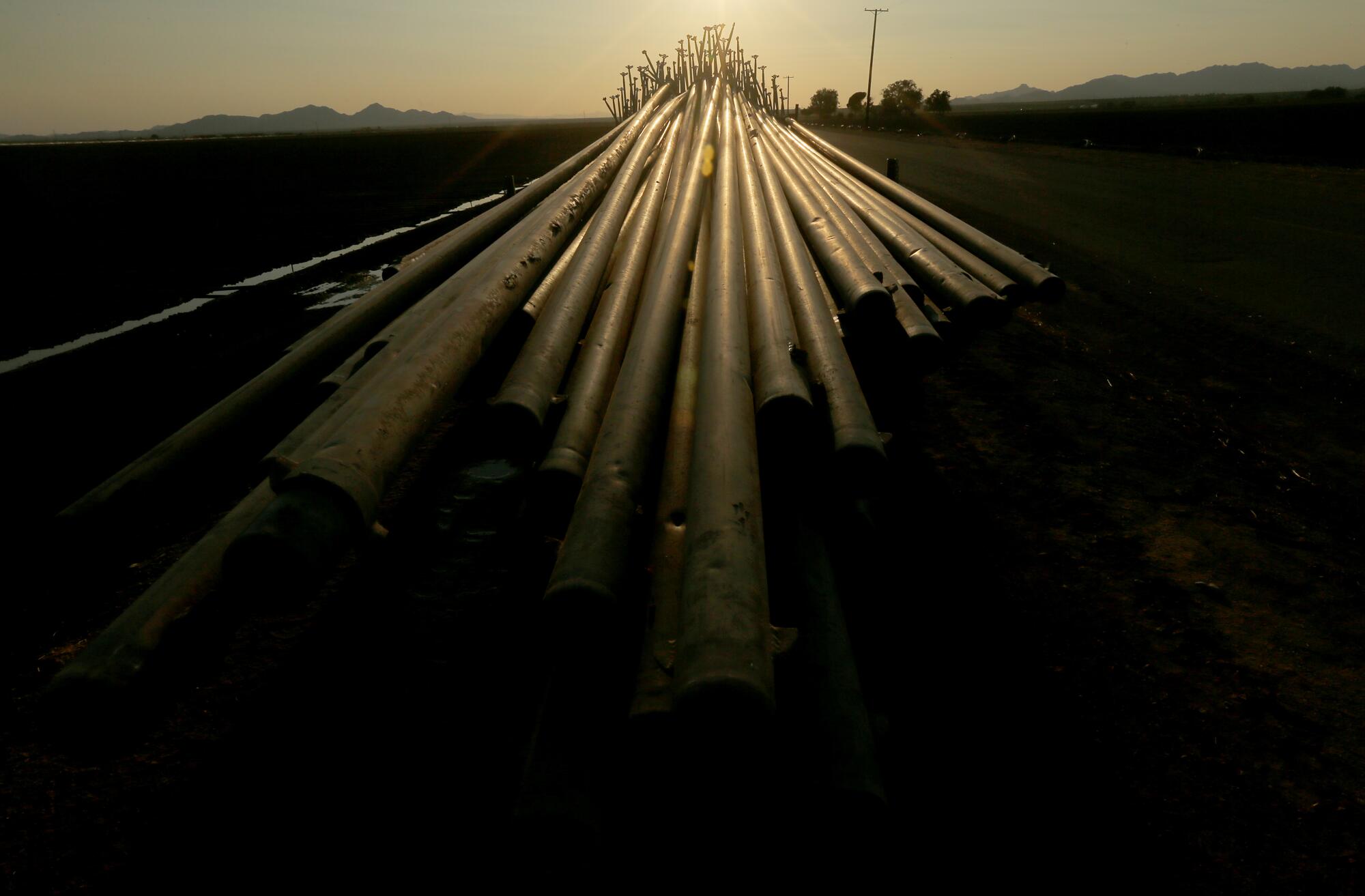
To the farmers’ dismay, the MWD has bought large pieces of farmland in the Palo Verde Valley. The largest purchase, 12,000 acres in 2015, made the MWD the largest landowner in the irrigation district. The MWD says it now owns about 29,000 acres in the area.
The agency leases the land that isn’t left dry to growers, offering reduced rent to farmers who plant crops that consume less water.
The problem with the MWD owning so much land, Fisher said, is that it ends up paying less to landowners in the valley. He said this deprives the area of approximately $6 million to $8 million annually that would otherwise be going to local businesses and fueling the economy.
“When [the MWD] fallows their own land, they keep the money. So it doesn’t make its way into our community. And it’s a lot for a little community like this,” Fisher said.
Worried by the MWD’s land dealings, leaders of the Palo Verde Irrigation District sued the agency in 2017, but then dropped the lawsuit in 2018.
Recently, farmers objected when they learned of an MWD proposal to buy an additional 702-acre property from Cox Family Farms. The MWD board endorsed the purchase last month.
“We’ve told them that we think it’s a very bad idea. It’s bad for the community, and frankly, it’s a predatory practice on their part,” Fisher said. “It’s just disappointing. It’s sort of counter to the spirit by which we originally engaged with them to negotiate the fallow program.”
At the MWD, however, officials have discussed the potential for additional purchases of farmland along the river in areas with high-priority senior rights as a way to reduce water use in agriculture and free up water for urban Southern California in dry times.
“It would allow us to play a long game with climate change by holding and leasing land for decades,” Brad Coffey, manager of water resources management, said during a September committee meeting.
Board members discussed whether to actively pursue future land purchases.
“I believe that if someone wants to sell us that land, that we should always answer the door,” board member Larry Dick said. “We’ll do it responsibly. We’re not going to take that land and take it out of production forever.”
Russell Lefevre, another board member, asked how the land purchases are viewed by the farmers.
“They did express concern about us buying land,” said Hasencamp, MWD’s manager of Colorado River resources. “We are working with them to try to alleviate some of those concerns.”
Lefevre said he would support seeking out other land deals. He said he wonders “if we can move this methodology to other areas,” such as the Coachella and Imperial valleys.
